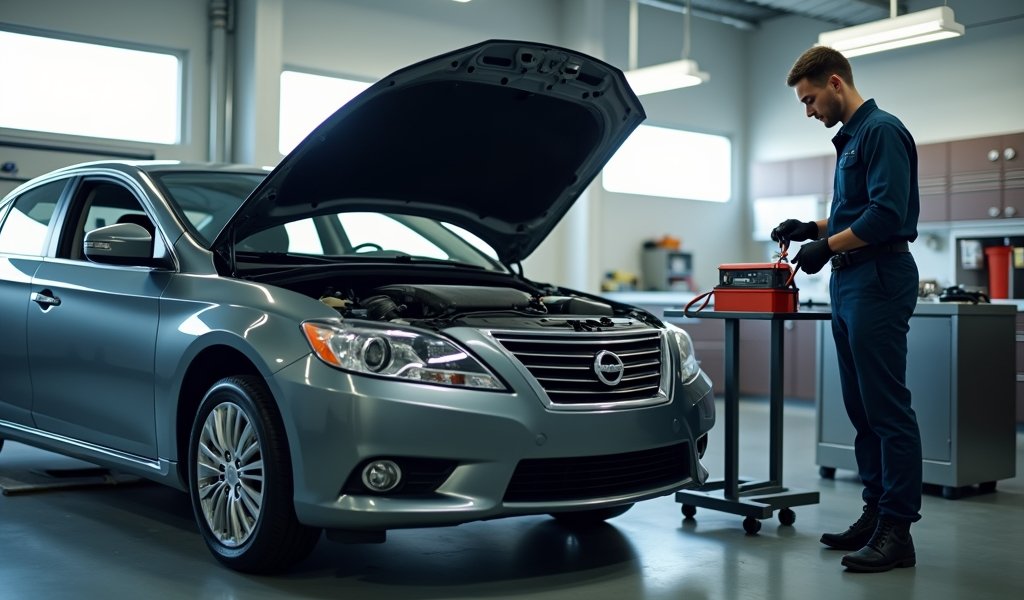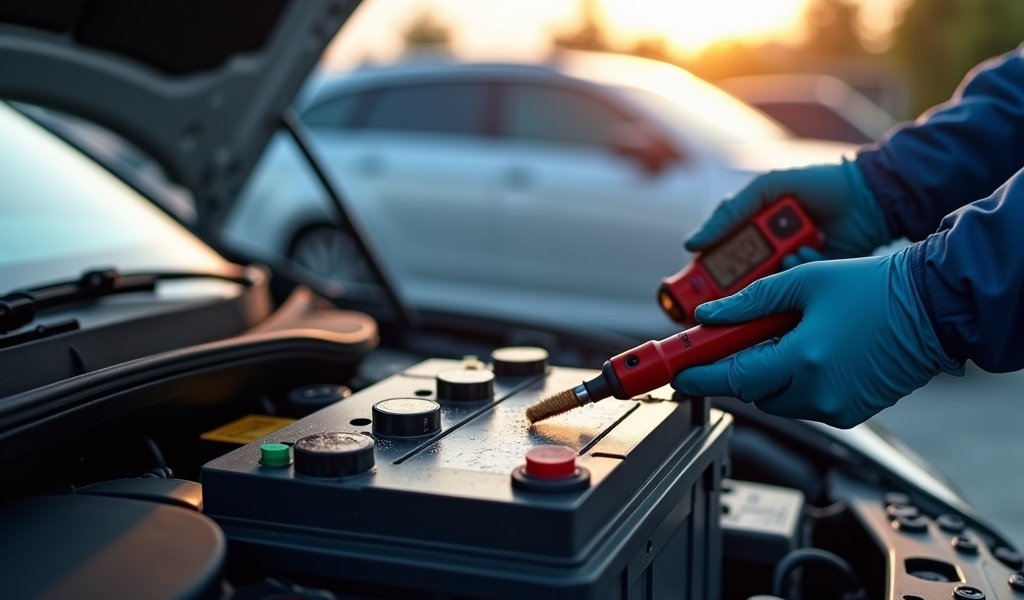Overview
This article presents ten essential car battery maintenance strategies to extend battery life, including regular inspection, terminal cleaning, proper securing, limiting short trips, managing electronics usage, protecting from extreme temperatures, driving regularly, using battery maintainers, checking the charging system, and investing in quality replacements. By implementing these maintenance practices, drivers can significantly improve their battery’s lifespan, save money on replacements, and avoid the frustration of unexpected battery failures.
Table of Contents
- Understanding Car Batteries: The Heart of Your Vehicle’s Electrical System
- Signs Your Car Battery Might Be Struggling
- 1. Regular Inspection: The Foundation of Battery Maintenance
- 2. Keep Terminals Clean: Preventing Corrosion and Resistance
- 3. Secure Your Battery: Eliminating Vibration Damage
- 4. Limit Short Trips: Give Your Battery a Chance to Recharge
- 5. Manage Your Electronics: Reduce Unnecessary Drain
- 6. Weather Protection: Shielding from Temperature Extremes
- 7. Drive Regularly: Keep Your Battery Active
- 8. Use a Battery Maintainer: The Perfect Solution for Infrequent Use
- 9. Check Your Charging System: Ensuring Proper Battery Replenishment
- 10. Invest in Quality When Replacing: The Value of a Good Battery
- Conclusion: Maximizing Your Car Battery’s Lifespan
- Frequently Asked Questions
Understanding Car Batteries: The Heart of Your Vehicle’s Electrical System
Your car battery is more than just a box under the hood – it’s the lifeblood of your vehicle’s electrical system. As a mechanic with over 15 years of experience, I’ve seen countless drivers surprised by unexpected battery failures that could have been prevented with proper car battery maintenance tips. The average car battery lasts between 3-5 years, but with the right care, you can maximize its lifespan and avoid those frustrating moments when your car just won’t start.
Car batteries might seem simple, but they’re remarkable devices that store chemical energy and convert it to electrical energy on demand. This stored power is what cranks your engine, powers your lights, and keeps your radio playing your favorite tunes. However, batteries face constant challenges: temperature extremes, vibration, and the natural degradation that comes with use.
In this guide, I’ll walk you through 10 proven methods to extend your car battery’s life, saving you money and the headache of unexpected failures. These tips come from years in the garage and represent the best car maintenance practices I’ve seen work time and time again. Let’s get your battery the care it deserves!
Signs Your Car Battery Might Be Struggling
Before diving into maintenance tips, it’s crucial to recognize when your battery might be calling for help. Catching problems early can mean the difference between a simple maintenance procedure and a complete replacement.
Watch out for these warning signs:
- Slow engine crank: That labored “rur…rur…rur” sound before your engine starts
- Dimming headlights, especially when idling
- Battery warning light illuminated on your dashboard
- Electrical components behaving erratically
- Swollen battery case (a sign of overheating)
- The need to press the gas pedal to start (a dangerous practice you should avoid)
If you notice any of these symptoms, don’t wait – your battery is sending an SOS. According to AAA’s research on battery lifespan, ignoring these early warning signs often leads to complete battery failure within just a few weeks.
Now, let’s explore the maintenance practices that will keep your battery healthy for years to come.

1. Regular Inspection: The Foundation of Battery Maintenance
The cornerstone of effective car battery maintenance tips is regular inspection – I recommend checking your battery every time you change your oil. Look for any signs of damage to the casing, including cracks, bulges, or leaks. A damaged case can lead to acid leaks and dangerous situations, not to mention premature battery failure.
Next, examine the battery terminals and cables. They should be tight, clean, and free of corrosion. If you spot the telltale white or greenish powder around the terminals, that’s corrosion forming – a common cause of poor connections and starting problems.
Don’t forget to check your battery’s mounting bracket as well. A loose battery can shift around while driving, potentially causing internal damage or disconnecting terminals. If anything feels loose, tighten it appropriately or have a professional take a look.
For those who live in extreme climates, more frequent inspections are wise. Both extreme heat and cold can accelerate battery wear, making regular checks all the more important for drivers in these regions.
2. Keep Terminals Clean: Preventing Corrosion and Resistance
Corrosion on battery terminals is like cholesterol in arteries – it restricts the flow of power and puts extra strain on your battery. Keeping terminals clean is one of the most straightforward yet effective car battery maintenance tips I share with my customers.
To clean corroded terminals, first disconnect the battery (always remove the negative cable first, then the positive). Mix a simple solution of baking soda and water – about a tablespoon of baking soda to a cup of water. This mixture neutralizes the acidic corrosion and makes cleaning easier.
Use an old toothbrush dipped in your solution to scrub the terminals and cable ends. For stubborn deposits, a wire brush attachment for your drill can make quick work of the job. After cleaning, rinse with a small amount of clean water and dry thoroughly with a shop towel.
Once everything is clean and dry, apply a thin coat of petroleum jelly or commercial battery terminal protectant to the terminals before reconnecting. This creates a protective barrier that slows future corrosion. Remember when reconnecting: positive first, then negative.
I’ve seen this simple maintenance step add months or even years to a battery’s life, especially in humid climates where corrosion tends to form more quickly. Make this a part of your DIY car maintenance routine every 3-6 months for best results.
3. Secure Your Battery: Eliminating Vibration Damage
Every pothole, speed bump, and rough road your car traverses sends vibrations through your vehicle. While your car’s suspension system handles most of this punishment, your battery can still suffer from excessive movement if not properly secured.
Vibration is a silent battery killer. Inside your battery, vibration can cause the plates to flex and shed active material, gradually reducing capacity and shortening lifespan. The U.S. Department of Energy research has found that vibration damage is a significant factor in premature battery failure in vehicles.
Check your battery’s hold-down clamp or bracket during your regular inspections. It should be snug but not overtightened – you want to prevent movement without stressing the battery case. If your battery can move even slightly when you push on it (with the engine off, of course), it needs to be secured better.
If your vehicle didn’t come with a proper hold-down system, or if the original has been lost or damaged, aftermarket solutions are readily available and relatively inexpensive. This small investment can significantly extend your battery’s useful life by preventing internal damage from constant vibration.
4. Limit Short Trips: Give Your Battery a Chance to Recharge
Starting your car requires a significant power draw from your battery – in fact, it’s the most demanding task your battery performs. Under normal driving conditions, your alternator recharges the battery after startup, maintaining a healthy cycle of discharge and recharge.
However, frequent short trips can create an imbalance in this cycle. If you’re only driving for a few minutes at a time, your battery never gets fully recharged before being called upon to start the car again. Over time, this pattern leads to a chronically undercharged battery, a condition known as “sulfation” where lead sulfate crystals build up on the battery plates.
If your driving habits typically include lots of short trips, try to combine errands into longer drives occasionally. A good rule of thumb is to aim for at least one 20-minute drive weekly to ensure your battery gets properly recharged.
For vehicles that sit for extended periods between short trips, consider investing in a battery maintainer (more on this later). These devices can help keep your battery at optimal charge levels even when your car isn’t being driven regularly, preventing the damage caused by chronic undercharging.
5. Manage Your Electronics: Reduce Unnecessary Drain
Modern vehicles are packed with electronics that can draw power from your battery even when the engine is off. While individual systems might use minimal power, collectively they can drain your battery if left unchecked, especially during extended parking.
Develop the habit of checking that all lights are off before leaving your vehicle. This includes dome lights, headlights (even daytime running lights on some vehicles), and trunk lights. A single dome light left on overnight can drain enough power to prevent your car from starting the next morning.
Be mindful of accessories plugged into your car’s power outlets or USB ports. Phone chargers, dash cams, and other devices can continue drawing power even when not actively charging a device. Either unplug these items when not in use or invest in outlets that automatically cut power when the ignition is off.
If you have aftermarket electronics like amplifiers or additional lighting, ensure they’re installed with proper relays and connections that don’t create parasitic drains on your battery. Poorly installed aftermarket equipment is one of the most common causes of mysterious battery drain I see in my shop.

6. Weather Protection: Shielding from Temperature Extremes
Your car battery faces its toughest challenges during temperature extremes. Both hot and cold weather can significantly impact battery performance and lifespan, but for different reasons.
In extreme heat, battery fluid can evaporate, leading to internal damage and reduced capacity. Heat also accelerates the chemical reactions inside your battery, essentially causing it to age faster. If you live in a hot climate, parking in shade or a garage whenever possible can make a substantial difference in battery longevity.
Cold weather brings its own challenges. Battery capacity temporarily decreases in cold temperatures – at 32°F, a battery might deliver only 65% of its normal power, and at 0°F, that can drop to 40%. This reduction happens just when your engine needs more power to start due to thickened oil.
Consider using a battery insulation kit if you live in a region with extreme temperature swings. These thermal wraps help maintain more consistent battery temperatures, reducing stress from thermal cycling. For extremely cold climates, battery warmers can be a worthwhile investment, especially for vehicles that must start reliably in sub-zero conditions.
Remember that temperature protection isn’t just about extending battery life – it’s also about ensuring reliability when you need it most. Few things are worse than being stranded due to a battery that can’t handle the weather conditions.
7. Drive Regularly: Keep Your Battery Active
Batteries, like people, don’t do well when left idle for too long. Regular use keeps the chemical components mixed and active, preventing stratification (where acid concentrates at the bottom of the battery) and keeping the plates free from excessive sulfate crystal buildup.
Try to drive your vehicle at least once a week for a minimum of 20-30 minutes. This ensures that your battery receives a proper charging cycle and stays in good condition. Highway driving is particularly effective as it allows your alternator to operate consistently at an optimal RPM range for charging.
If your vehicle must sit unused for extended periods (such as seasonal vehicles or during extended travel), you have two good options. First, you can disconnect the negative battery terminal to prevent any drain (though this will reset your electronic systems). Alternatively, and preferably, use a battery maintainer as discussed in the next section.
For collectors or those with seasonal vehicles, establishing a rotation schedule to start and run each vehicle regularly can be an effective way to maintain multiple batteries simultaneously. This simple routine is part of proper car maintenance tips that can save you considerable money and hassle in the long run.
8. Use a Battery Maintainer: The Perfect Solution for Infrequent Use
For vehicles that sit for extended periods – whether it’s a classic car, a seasonal vehicle, or just a car you don’t drive often – a battery maintainer (also called a trickle charger or float charger) is an essential investment.
Unlike standard battery chargers that deliver a constant charge regardless of battery condition, maintainers are smart devices that monitor battery status and provide just enough power to keep the battery at optimal charge. This prevents both overcharging and the sulfation that occurs with undercharging.
Modern maintainers are remarkably user-friendly. Most feature simple clip-on connections and can be left attached indefinitely without risk of damage. Many also include desulfation modes that can help revive batteries suffering from sulfate crystal buildup due to infrequent use.
When selecting a maintainer, look for models with automatic switching between charging and float modes, reverse polarity protection, and spark-proof connections. Units with LED indicators showing charge status provide helpful feedback on your battery’s condition.
For under $50, a quality maintainer can extend your battery’s life by years, particularly for vehicles that experience irregular use patterns. It’s one of the most cost-effective insurance policies against battery failure you can buy.
9. Check Your Charging System: Ensuring Proper Battery Replenishment
Even the best battery maintenance routine can be undermined by a faulty charging system. Your vehicle’s alternator and voltage regulator must function properly to keep your battery appropriately charged without overcharging it.
A healthy charging system should produce between 13.8 and 14.7 volts while the engine runs at about 2,000 RPM. This voltage range ensures your battery receives proper charging current while preventing the damage that can result from excessive voltage.
You can check your charging system with a simple voltmeter – connect it to your battery terminals with the engine running and lights off. If the reading falls outside the optimal range, further investigation is needed. Too low indicates an alternator that’s not keeping up with your vehicle’s electrical demands; too high suggests a faulty voltage regulator that could damage your battery through overcharging.
Pay attention to warning signs of alternator problems: dimming lights when you accelerate, a battery warning light that comes and goes, or electrical accessories that seem to run at varying speeds or brightness. These symptoms often indicate charging system issues that will eventually lead to battery failure if not addressed.
Having your charging system tested annually (most auto parts stores will do this for free) can catch problems before they affect your battery’s health and leave you stranded.
10. Invest in Quality When Replacing: The Value of a Good Battery
When the time eventually comes to replace your battery, resist the temptation to choose solely based on price. The cheapest option rarely offers the best value in terms of performance and longevity.
Look for batteries with features like robust construction, vibration resistance, and appropriate reserve capacity for your vehicle’s needs. AGM (Absorbent Glass Mat) batteries, while more expensive initially, often provide better performance, longer life, and greater resistance to deep discharge damage than traditional flooded batteries.
Always choose a battery that meets or exceeds your vehicle manufacturer’s specifications for cold cranking amps (CCA) and size. A battery with insufficient CCA may start your vehicle in mild weather but leave you stranded in colder temperatures.
Check manufacturing dates when purchasing – batteries begin deteriorating from the moment they’re produced, even if unused. Look for a battery manufactured within the past six months for maximum service life.
Remember that proper installation matters too. Ensure terminals are clean, connections are tight (but not overtightened), and the battery is securely mounted. Taking care during installation sets the stage for years of reliable service from your new battery.
Conclusion: Maximizing Your Car Battery’s Lifespan
Implementing these car battery maintenance tips can significantly extend your battery’s useful life, saving you money and the inconvenience of unexpected failures. From regular inspections and cleaning to smart driving habits and investing in quality components, each strategy plays a role in overall battery health.
Remember that battery maintenance isn’t just about longevity – it’s about reliability. Few automotive problems are as frustrating as turning your key and hearing nothing but silence. By incorporating these maintenance practices into your regular routine, you’re ensuring your vehicle starts reliably when you need it most.
Most of these maintenance tasks require minimal time and tools, making them accessible even to those without extensive mechanical experience. The small investment in preventative maintenance pays dividends through extended battery life and increased reliability.
Have you found these car battery maintenance tips helpful? Do you have questions about specific aspects of battery care? Get in Touch Today! You can contact us with your battery questions, and we’ll be happy to provide personalized advice for your specific situation.
Frequently Asked Questions
How often should I replace my car battery?
Most car batteries last between 3-5 years depending on climate, usage patterns, and maintenance. Replace yours when it consistently struggles to hold a charge or shows signs of physical damage.
Can I jump-start a car with a completely dead battery?
Yes, but it’s not ideal for battery health. Jump-starting puts strain on electrical components and should be considered a temporary solution until you can properly charge or replace the battery.
Is it normal for batteries to get hot while charging?
Slight warmth is normal, but hot batteries indicate a problem. Disconnect immediately if your battery becomes hot during charging as this can indicate internal damage or an impending dangerous failure.
Can I test my car battery at home?
Yes, using a multimeter to check voltage (should be 12.6V when fully charged) or a load tester for more thorough evaluation. Many auto parts stores also offer free battery testing services.
Should I disconnect my battery when storing my car long-term?
Either disconnect the negative terminal or use a battery maintainer for long-term storage. Simply disconnecting prevents drain but doesn’t prevent natural self-discharge, which is why maintainers are preferred for extended storage.


Pingback: car battery maintainer for storage: Tips - knowsyourcar.com